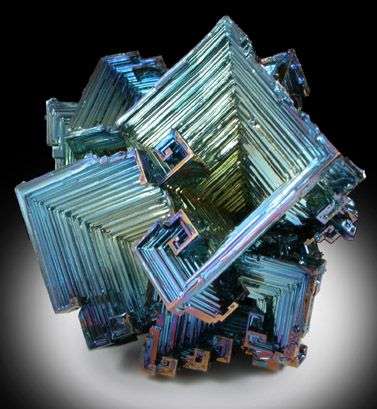
Appearance
Brittle and dark pink-silver in color, bismuth frequently exhibits an iridescent oxide patina that changes color from yellow to blue. A greater growth rate around the outside edges than on the inside margins gives bismuth crystals their spiral, stair-stepped form. Different light wavelengths interfere with one another upon reflection because of changes in the thickness of the oxide layer that forms on the crystal’s surface, producing a rainbow of colors.

Geographical Distribution
About twice as much bismuth as gold is found in the crust of the Earth. South Korea, China, and Laos generate the majority of the world’s bismuth. In other nations, bismuth is a by-product of mining other metals; there is just one primary bismuth mine in Bolivia.
History
Given that bismuth may be found in both its original state and in compounds, it was clearly recognized fairly early on. But for a very long time, it was mistaken for other metals, including lead, antimony, and tin, and was not properly acknowledged as a distinct metal. It seems that miners in the Middle Ages thought bismuth was a step in the process of turning base metals into silver, thus they were shocked to find a vein of the metal, thinking they had stopped the process. This component is referred to as Wismut in the works of the German monk Basil Valentine from the fifteenth century; the term may have originated from a German expression meaning “white mass.”
In any case, the mineralogist Georgius Agricola Latinized it to bisemutum after identifying its unique characteristics and outlining the process for extracting it from its ores. By the middle of the eighteenth century, bismuth had gained recognition as a distinct metal. German scientist Johann Heinrich Pott published studies on the subject in 1739, while Frenchman Claude-François Geoffroy published his findings on the subject in 1753.
Chemical Composition
The atom of bismuth is both a metal and a pnictogen. The element bismuth has the atomic weight of 208.98, atomic number 83, and atomic symbol Bi. The formula for the mineral bismuth is Bi.
Uses
Approximately half of the bismuth produced worldwide comes from bismuth compounds. They can be found in colors, cosmetics, and some medications, most notably bismuth subsalicylate, which is used to treat diarrhea. Some of the uses of bismuth, such as printing type casting, are due to its peculiar tendency to expand as it solidifies. For a heavy metal, bismuth has exceptionally low toxicity when it is in its basic form. In the 20th century, as lead’s toxicity and the expense of its environmental remediation became increasingly evident, appropriate bismuth alloys gained appeal as lead substitutes. Currently, lead was used to fill around one-third of the world’s bismuth production.
Table





